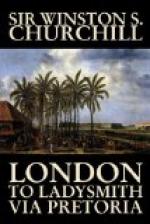The right battalions drew up in many long lines on the sides of the river gorge. Then men began gradually to work their way upwards, until all the dead patches of ground and every scrap of cover sheltered a fierce little group. Behind the railway embankment, among the rocks, in the scrub, in a cutting, near a ruined house, clusters of men eagerly awaited the decisive moment: and all this time more than seventy guns concentrated their fire on the entrenchments, scattering the stones and earth high in the air. Then, suddenly, shortly after four o’clock, all further attempts at advancing under cover were abandoned, and the Lancashire Brigade marched proudly into the open ground and on the enemy’s works. The Mauser musketry burst forth at once, and the bullets, humming through the assaulting waves of infantry, reached us on our hillside and wounded a trooper in spite of the distance. But, bullets or no bullets, we could not take our eyes off the scene.
The Lancashire Brigade advanced on a wide front. Norcott’s Riflemen were already prolonging their line to the right. The Boer fire was dispersed along the whole front of attack, instead of converging on one narrow column. The assault was going to succeed. We stood up on our rocks. Bayonets began to glitter on the distant slope. The moving lines increased their pace. The heads of the Boers bobbing up and down in their trenches grew fewer and fewer. They knew the tide was running too strongly. Death and flight were thinning their ranks. Then the sky-line of Railway Hill bristled with men, who dropped on their knees forthwith and fired in particular haste at something that was running away down the other side. There was the sound of cheering. Railway Hill was ours. I looked to the left.
The neck between the hills was lined with trenches. The South Lancashire Regiment had halted, pinned to the ground by the Boer fire. Were they going to lose the day for us when it was already won? The question was soon answered. In an instant there appeared on the left of the Boer trench a dozen—only a dozen—violent forms rushing forward. A small party had worked their way to the flank, and were at close quarters with cold steel. And then—by contrast to their former courage—the valiant burghers fled in all directions, and others held out their rifles and bandoliers and begged for mercy, which was sometimes generously given, so that by the time the whole attack had charged forward into the trenches there was a nice string of thirty-two prisoners winding down the hill: at which token of certain victory we shouted loudly.
Inniskilling Hill alone remained, and that was almost in our hands. Its slopes were on three sides alive with the active figures of the Light Brigade, and the bayonets sparkled. The hill ran into a peak. Many of the trenches were already deserted, but the stone breastwork at the summit still contained defenders. There, painted against the evening sky, were the slouch hats and moving rifles. Shell after shell exploded among them: overhead, in their faces, in the trench itself, behind them, before them, around them. Sometimes five and six shells were bursting on the very apex at the same instant. Showers of rock and splinters fell on all sides.




